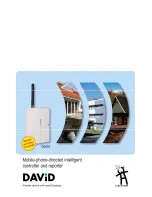
GD-04 DAVID
MKS51200_OS1
2
1.2.
David can be used as:
•
A switch with SMS remote control.
SMS texts for switching particular terminals on/off are
configurable.
•
A time-switch
which can be activated remotely via a mobile phone (the switch-on period is
configurable from 1 second to 10 hours).
•
A relay with dialling-in remote control
. Up to 50 tel. numbers can be authorized for each
relay. Because calls are not answered dialling-in control within GSM is free of charge. (David
only checks the caller’s number and – if the number is authorized – responds with relay
activation.) This can be used for parking latch control etc.
•
A relay with validity-limited dialling-in remote control
. Each authorized number can have
a limit to the number of calls. When the call count reaches the limit the tel. number is de-
authorized. This can be useful for pre-paid services such as e.g. parking. Any tel. number can
be re-authorized via SMS by the administrator.
•
An SMS reporter
. Input A to D activations or deactivations can be reported by SMS and
optionally confirmed by phone calls. Each input can have its own message texts and up to 8
tel. numbers programmed.
1.3.
David can be supplemented with:
•
A GD-04A back-up module,
which provides David with the ability to work
approx. 12 to 24
hours continually without an external power supply
,
see
11.1.
•
A GD-04D DTMF module,
which allows you to control David’s output relays by entering
numeric codes (DTMF codes) on the telephone keypad during calls, see 11.2.
•
A GD-04P link cable
, which allows you to connect David to a PC through a USB port and
perform any desired configuration using GDLink software.
•
A GD-04R radio module
, which allows
input
A to D
activations via wireless buttons or
detectors
of the OASiS series and also provides David with the capability of output relay X or
Y state transmission to UC or AC OASiS receivers. In addition, you can control relays X or Y
“locally” via RC-8x keyfobs
(so that an appliance can be controlled both via a mobile phone
and a keyfob). The module also allows heating control (again locally or remotely via a mobile
phone) using wireless thermostats of the TP-8x series.
A detailed description of optional accessories can be found in chapter 11.
2. David’s SIM card
•
In order to function, David needs a
SIM card
, preferably a tariffed one.
•
Test the
SIM card
by using it in your mobile phone – SMS sending and calling must work
correctly.
•
Switch off the PIN code protection
via the phone menu (or set the PIN code to 1234).
•
Check the GSM signal strength
in David’s location.
3. Installation
1. The GSM
antenna should not be shielded by metals
. If necessary, an external antenna
designed for the 900/1800MHz GSM band can be connected via a 50
Ω
SMA connector.
2. Open the cover and
release the electronic circuit board
by pressing the tabs.
3.
Mount the rear plastic
cover at the desired location.
4.
Insert a SIM card:
Open the SIM card case by shifting the moving part in the direction of the
terminals and tipping it off. Make sure that the card is correctly oriented and insert it. Close
the SIM card case (fold and re-shift the moving part).
5. Insert the
circuit board back
to its position.
6. Do the wiring, see below.


































